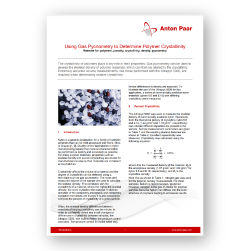Using Gas Pycnometry to Determine Polymer Crystallinity
Click below to download this Application Note

Nylon is a generic designation for a family of synthetic polymers that can be melt-processed into fibers, films, or shapes. Quality control laboratories in nylon manufacturing require that material characterization be performed as quickly and accurately as possible. For many polymer materials, properties such as skeletal density and percent crystallinity are crucial for manufacturers to ensure their materials are consistent across batches.
Crystallinity affects the volume of a material and the degree of crystallinity can be detected using a technique such as gas pycnometry. The mass and measured volume of the sample are used to calculate the skeletal density. This correlates with the crystallinity of a material, where the higher the skeletal density, the more crystalline the material. If skeletal densities of the completely amorphous and completely crystalline formations are known, it is also possible to compute the percent of crystallinity of a given sample.
Often, the skeletal density differences between materials of varying crystallinity can be minute. In order to confidently detect any small changes or differences in crystallinity between samples, the Ultrapyc 5000, with built-in Peltier temperature control was used. Temperature control is crucial when only limited differences in density are expected. To illustrate the use of the Ultrapyc 5000 for this application, a series of commercially available nylon materials (grade 6.6 and 6.10) with differing crystallinity were measured.

About Anton Paar USA
Anton Paar USA is a subsidiary of the Graz, Austria-based Anton Paar. Anton Paar is the world’s premier manufacturer of measuring and analytical instrumentation used by laboratories and manufacturers during both research and development and quality control. Founded in 1922, Anton Paar now has subsidiaries in 31 different countries across the world.
Since the beginning of 2018, Anton Paar USA has expanded its USA operations to include four regional offices, with full sales and laboratory operations now taking place in Torrance, California, Houston, Texas, and Chicago, Illinois, while the main Anton Paar USA headquarters remains in Ashland, Virginia.

